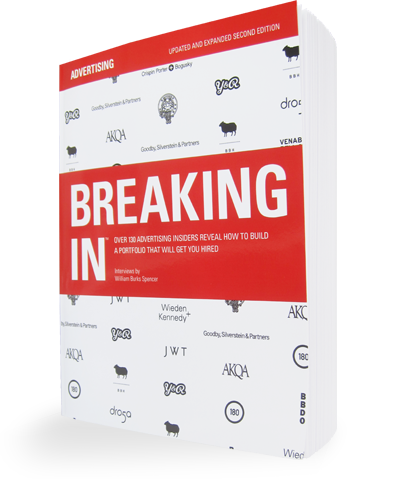SG: …I don’t know if you were going to ask this, but I’m going to say it anyway: I think one of the things that’s really important with the junior portfolios is that they represent something outside of just who they are as it relates to advertising. So when people put together their books, if they are a screenwriter, or if they are an artist, or if they have a T-shirt company, or if they walk dogs on the side—whatever makes someone memorable—I think when that’s included somehow in their portfolio, it gives whoever is interviewing them something to relate to other than an ad and it gives them a talking point. So if you have something that’s interesting—that you grew up on a horse farm or whatever it is—then people are like, “Oh yeah. I remember that person’s portfolio, isn’t that the guy who grew up on the horse farm?”
WS: That was one of my questions, and you answered it.
SG: Oh, there you go.
WS: What do you think about long copy? Is that important these days?
SG: I think so, especially with the web. I think portfolios need to play to somebody’s strengths. I’m a firm believer that it’s not the library of everything you’ve ever done; it’s your ad for people to hire you. So I think you want to give examples of things that are beyond one word so that people can see that you can actually write, if you’re a writer. But at the same time, if that’s not somebody’s strength, they shouldn’t put it in. I think this happens even with junior portfolios, that people will ask for more. If they see something in it that they see potential in, or they see some good ideas, they might come back and say, “Do you have any long body copy?” Or radio or whatever it might be. And then that person has an opportunity to show more than what they have put into their portfolio.
WS: Do you have any other advice or any tips for someone who’s just starting out or looking for their first job?
SG: Put together a portfolio that’s easy to navigate, if it’s online, which I think most people have to do now. I think people get encumbered by wanting to put together fancy, beautiful websites with interesting navigation. And when people get lost, or they’re waiting for things to download, they lose their patience.
But I think that being organized in the job search is half the battle, to be honest. I think that you have to know where you sent your portfolio. You have to know when you sent them your portfolio. You have to know how to oh-so-gently, casually follow up on whether or not they looked. You have to be scrupulous about note taking so that they know you’re not…there’s a fine line between stalking and oh-so-gently reminding somebody that you exist, and following up.
Also, make sure you have no typos in your book. And networking: In the end it’s about relationships, and people like to help people who they know. And alumni connections can be really helpful for people. But because of websites, you can send stuff so frequently. And I think creative managers and creative directors get inundated. So it’s very hard to figure out: how do you make yourself stand out? And it’s a really tough…anything clever can help. I mean there was a junior team last year that they did some crazy video that they were sending around with their portfolio. And they got a job. But they did something really clever, and really smart. And it was more than the “Hi, I need help, looking for my first job,” which I have 100 of in my inbox right now.

Comments are closed.